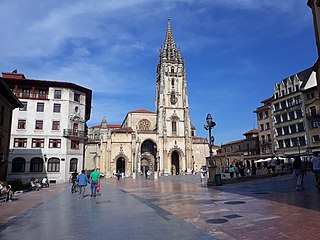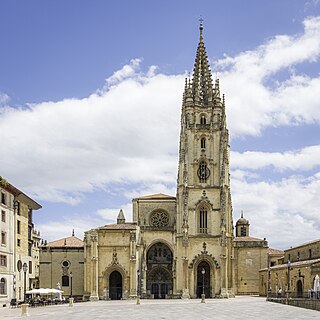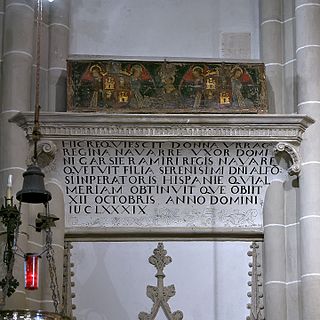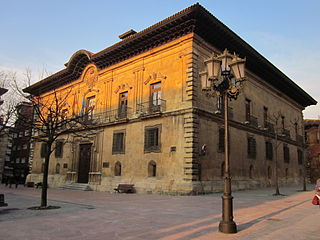
Segovia is a city in the autonomous community of Castile and León, Spain. It is the capital and most populated municipality of the Province of Segovia. Segovia is in the Inner Plateau, near the northern slopes of the Sistema Central range and on a bend of the Eresma river.

Oviedo or Uviéu is the capital city of the Principality of Asturias in northern Spain and the administrative and commercial centre of the region. It is also the name of the municipality that contains the city. Oviedo is located approximately 24 km (15 mi) southwest of Gijón and 23 km (14 mi) southeast of Avilés, both of which lie on the shoreline of the Bay of Biscay. Oviedo's proximity to the ocean of less than 30 kilometres (19 mi) in combination with its elevated position with areas of the city more than 300 metres above sea level causes the city to have a maritime climate, in spite of its not being located on the shoreline itself.

The Metropolitan Cathedral Basilica of the Holy Saviour or Cathedral of San Salvador is a Roman Catholic church and minor basilica in the centre of Oviedo, in the Asturias region of northern Spain.

Arcos de la Frontera is a town and municipality in the Sierra de Cádiz comarca, province of Cádiz, in Andalusia, Spain. It is located on the northern, western and southern banks of the Guadalete river, which flows around three sides of the city under towering vertical cliffs, to Jerez and on to the Bay of Cádiz. The town commands a fine vista atop a sandstone ridge, from which the peak of San Cristóbal and the Guadalete Valley can be seen. The town gained its name by being the frontier of Spain's 13th-century battle with the Moors.

Ciudad Colonial is the historic central neighborhood of the Dominican Republic's capital Santo Domingo. It is the oldest continuously inhabited European-established settlement in the Americas. The area has been declared a World Heritage Site by UNESCO. It is also known as Zona Colonial or more colloquially as "La Zona".

St. Michael of Lillo is a Roman Catholic church built on the Naranco mount, near the Church of Santa María del Naranco in Asturias. It was completed in 842 and it was consecrated by Ramiro I of Asturias and his wife Paterna in the year 848. It was originally dedicated to St. Mary until this worship passed to the nearby palace in the 12th century, leaving this church dedicated to Saint Michael. It has been a UNESCO World Heritage Site since 1985.

The Archdiocese of Oviedo is a Latin Church Archdiocese of the Catholic Church in Spain. The archdiocese encompasses roughly the current autonomous community of Asturias or Principality of Asturias. Erected in the 9th century, the diocese was elevated to an archdiocese in 1954. The diocesan see is in the city of Oviedo, where the Catedral de San Salvador is located.

The Church of Santo Adriano de Tuñón is a Roman Catholic Pre-Romanesque church in the village of Tuñón, Asturias, Spain dedicated to Saint Adrian.

The Abbey of San Juan Bautista de Corias is a former Benedictine monastery in Corias in Cangas del Narcea (Asturias), Spain, on the right bank of the Narcea River, dedicated to Saint John the Baptist. Today it is a historic site of the province, informally known as "the Asturian Escorial", due to the burial there of King Bermudo I of Asturias and his family.

Monasterio de San Salvador in Cornellana is a monastery located in Cornellana, municipality of Salas in Asturias, Spain.

Urraca Alfonso, also known as Urraca the Asturian, illegitimate daughter of Alfonso VII of León, was Queen Consort of Navarre by her marriage to García Ramírez. After becoming a widow, she returned to her homeland and was the regent of Asturias from 1153 to 1165. Urraca was involved in a rebellion against her half-brother, King Ferdinand II of León and with her second husband, Álvaro Rodríguez de Castro attempted to secure the independence of Asturias.
Velasquita Ramírez was Queen consort of León as the first wife of King Bermudo II and mother of infanta Cristina Bermúdez, wife of Ordoño Ramírez.

Cristina Bermúdez was an infanta of León, daughter of King Bermudo II and his first wife Queen Velasquita Ramírez. On her father's side, her grandparents were Ordoño III and Queen Urraca Fernández, daughter of count Fernán González of Castile. Her grandparents on her mother's side were most probably Count Ramiro Menéndez and his wife Adosinda Gutiérrez, both members of the highest Galaico-Portuguese nobility.
Ordoño Ramírez, called "the Blind" was the son of King Ramiro III of León and Sancha Gómez, grandson of Sancho I of León and Queen Teresa Ansúrez and, on the maternal side, of Gómez Díaz, Count of Saldaña and Countess Muniadona Fernández.
Bermudo Ovéquiz was a member of the highest ranks of the nobility of Asturias, León, and Galicia who lived in the 11th century.

Camposagrado Palace is a baroque and Neo-classical palace located in the town of Oviedo, in Asturias, Spain. The building dates back to the eighteenth century and was built for the Marquis de Camposagrado, José Manuel Bernaldo de Quirós.

The Llano Ponte Palace is located on the corner of the Spanish Square, in the city of Avilés in Asturias, Spain. The property served as a private home until the 20th century when it became a school, a convent, and finally a theater. It is part of the historic preservation district of Avilés.
The following is a timeline of the history of the city of Oviedo, Spain.

Old Town of Cáceres is a historic walled city in Cáceres, Spain.




















